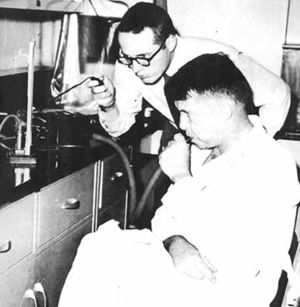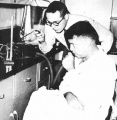Category:Biomedical equipment: Difference between revisions
From ETHW
No edit summary |
No edit summary |
||
| (2 intermediate revisions by one other user not shown) | |||
| Line 1: | Line 1: | ||
[[Image:Biomedical Equipment NASA Physical.jpg|thumb|right|An employee of The National Aeronautics and Space Administration conducting a physical ]] | |||
Equipment used in a biomedical settings, such as biomedical electrodes, implants and surgical instruments | Equipment used in a biomedical settings, such as biomedical electrodes, implants and surgical instruments | ||
== Subcategories == | == Subcategories == | ||
Revision as of 18:48, 10 January 2013
Equipment used in a biomedical settings, such as biomedical electrodes, implants and surgical instruments
Subcategories
- Biomedical electrodes - electrodes used to measure biological functions
- Biomedical telemetry - the use of implanted devices with low power demands to transmit data from a patient or organism to an external source
- Biomedical transducers - devices used to translate physiological signals into reliable data
- Catheters - tubes that can be inserted into any body cavity or vessel and that allow the removal or administration of fluids or access by surgical instruments
- Endoscopes - a device inserted directly into an organism used to "look inside" where direct line-of-sight examination is not possible
- Handicapped aids - tools or devices used to facilitate greater freedom or movement of handicapped persons
- Hypodermic needle - a hollow needle typically used with a syringe used to insert or extracts fluids from a body
- Implantable biomedical devices - a device which can be implanted directly into a body to repair or enhance a biological activity
- Implants - any device that can be placed in a body, for medical, decorative, monitoring, or other purposes
- Laparoscopes - a tool used to conduct a minimally invasive abdominal surgery through small incisions, usually attached to a camera
- Pacemakers - a medical device that uses electrodes to deliver electrical impulses to the heart muscles, regulating its beating
- Stethoscope - an acoustic device used for ausculation, or listening to the internal sounds of an animal body,
- Surgical instruments - any instrument which can be used to conduct a surgical procedure
Subcategories
This category has the following 7 subcategories, out of 7 total.
Pages in category "Biomedical equipment"
The following 37 pages are in this category, out of 37 total.
B
S
Media in category "Biomedical equipment"
This category contains only the following file.
- Biomedical Equipment NASA Physical.jpg 388 × 397; 22 KB

